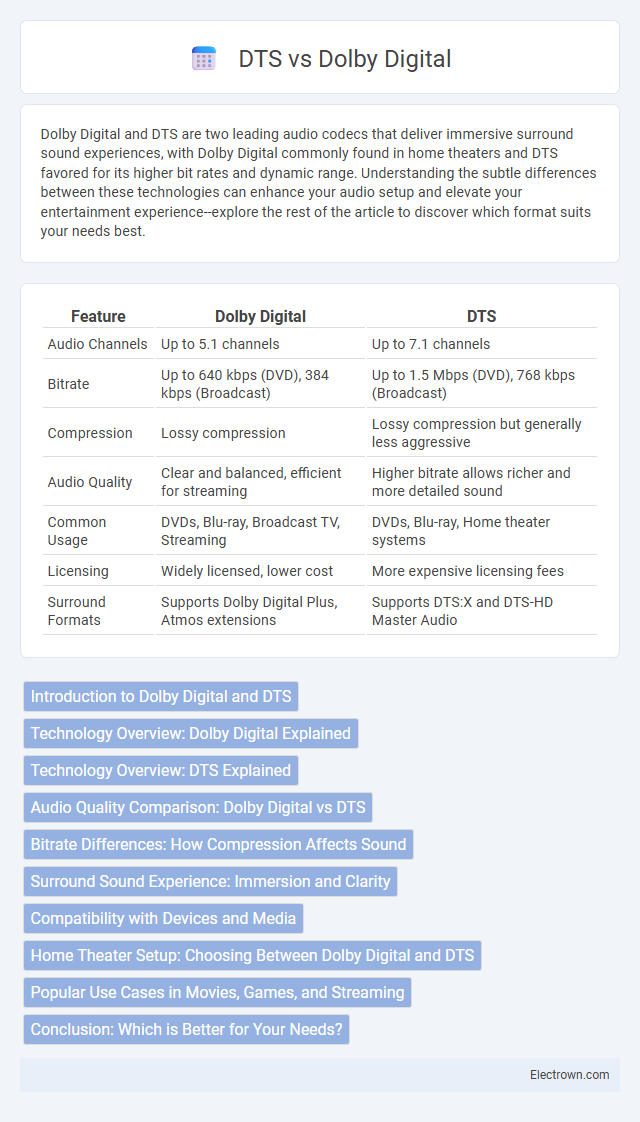Dolby Digital and DTS are two leading audio codecs that deliver immersive surround sound experiences, with Dolby Digital commonly found in home theaters and DTS favored for its higher bit rates and dynamic range. Understanding the subtle differences between these technologies can enhance your audio setup and elevate your entertainment experience--explore the rest of the article to discover which format suits your needs best.
Table of Comparison
| Feature | Dolby Digital | DTS |
|---|---|---|
| Audio Channels | Up to 5.1 channels | Up to 7.1 channels |
| Bitrate | Up to 640 kbps (DVD), 384 kbps (Broadcast) | Up to 1.5 Mbps (DVD), 768 kbps (Broadcast) |
| Compression | Lossy compression | Lossy compression but generally less aggressive |
| Audio Quality | Clear and balanced, efficient for streaming | Higher bitrate allows richer and more detailed sound |
| Common Usage | DVDs, Blu-ray, Broadcast TV, Streaming | DVDs, Blu-ray, Home theater systems |
| Licensing | Widely licensed, lower cost | More expensive licensing fees |
| Surround Formats | Supports Dolby Digital Plus, Atmos extensions | Supports DTS:X and DTS-HD Master Audio |
Introduction to Dolby Digital and DTS
Dolby Digital and DTS are leading audio compression technologies designed to enhance surround sound experiences in home theaters and cinemas. Dolby Digital, also known as AC-3, offers efficient compression with up to 5.1 channels, widely supported on DVDs, Blu-rays, and streaming platforms. DTS provides higher bit rates and supports up to 7.1 channels, appealing to audiophiles seeking richer, more immersive sound quality for your entertainment system.
Technology Overview: Dolby Digital Explained
Dolby Digital utilizes advanced audio compression technology to deliver high-quality surround sound in home theater systems, supporting up to 5.1 channels of audio for immersive entertainment experiences. It employs perceptual coding algorithms to efficiently reduce file size while maintaining clear dialogue, deep bass, and detailed sound effects. Your media setup benefits from Dolby Digital's widespread compatibility with Blu-ray players, streaming services, and gaming consoles, ensuring consistently rich and dynamic audio performance.
Technology Overview: DTS Explained
DTS (Digital Theater Systems) utilizes advanced audio compression techniques to deliver high-fidelity surround sound with less data loss compared to standard formats. It supports multiple channels, including DTS-HD Master Audio, which provides lossless audio quality for an immersive home theater experience. This technology emphasizes dynamic range and spatial accuracy, making it favored in cinema and high-end audio setups.
Audio Quality Comparison: Dolby Digital vs DTS
DTS offers higher bit rates, typically up to 1.5 Mbps, compared to Dolby Digital's maximum of 640 kbps, which can result in richer audio quality and better dynamic range. Dolby Digital is more widely supported across devices and streaming platforms, providing consistent surround sound performance, while DTS is favored in home theater setups for its enhanced clarity and detail. Your choice between Dolby Digital and DTS often depends on your audio system's compatibility and the desired immersive listening experience.
Bitrate Differences: How Compression Affects Sound
Dolby Digital typically uses bitrates ranging from 192 to 640 kbps, offering efficient compression that maintains clear dialogue and overall sound quality with minimal data. DTS often employs higher bitrates, from 768 to 1509 kbps, resulting in less compression and richer audio detail but requiring more storage and bandwidth. Understanding how these bitrate differences impact compression can help you choose the audio format that best balances sound fidelity and file size for your home theater setup.
Surround Sound Experience: Immersion and Clarity
Dolby Digital delivers a surround sound experience with precise channel separation and consistent clarity, making it ideal for immersive home theater environments. DTS offers higher bitrates and less compression, resulting in richer audio detail and enhanced dynamic range that boosts immersion. Your choice between Dolby Digital and DTS influences the overall surround sound quality, impacting the depth and realism of audio clarity during movie playback.
Compatibility with Devices and Media
Dolby Digital offers broad compatibility with most home theater systems, Blu-ray players, gaming consoles, and streaming services, making it highly accessible for Your entertainment setup. DTS, while providing comparable sound quality, is supported by a more limited range of devices and is often found in higher-end or specialized audio equipment. Choosing Dolby Digital ensures seamless playback across a wider array of media formats and consumer electronics.
Home Theater Setup: Choosing Between Dolby Digital and DTS
Dolby Digital and DTS are two leading surround sound formats widely used in home theater setups, each offering distinct audio encoding and bit rates that impact sound quality and compatibility. Dolby Digital typically provides a maximum bitrate of 640 kbps for 5.1 channels, ensuring clear dialogue and immersive effects, while DTS offers higher bitrates up to 1.5 Mbps, delivering richer audio detail and dynamic range. Selecting between them depends on your AV receiver's decoding capabilities, speaker configuration, and preference for sound fidelity in movies, gaming, or music playback.
Popular Use Cases in Movies, Games, and Streaming
Dolby Digital is widely used in movies and streaming platforms like Netflix and Amazon Prime due to its efficient compression and compatibility with most home theater systems. DTS is favored in gaming and high-end Blu-ray discs for its higher bitrate and multi-channel audio quality, providing immersive sound experiences. Both formats support surround sound setups, but Dolby Digital remains the industry standard for online streaming, whereas DTS excels in physical media and interactive entertainment.
Conclusion: Which is Better for Your Needs?
Dolby Digital offers broad compatibility with most home theaters and streaming platforms, making it ideal for everyday use and mainstream media consumption. DTS provides higher bitrates and better audio fidelity, catering to audiophiles and those seeking immersive sound quality in high-end setups. Choosing between Dolby Digital and DTS depends on your specific audio equipment, content sources, and preference for either widespread compatibility or enhanced sound performance.
Dolby Digital vs DTS Infographic

 electrown.com
electrown.com